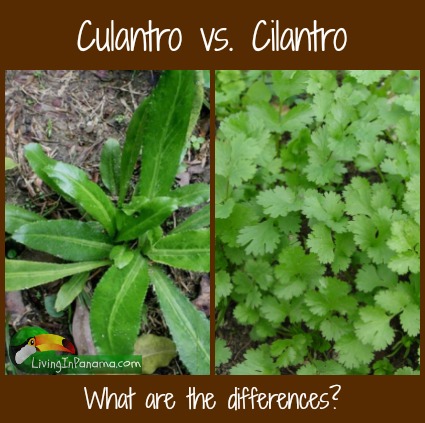
Culantro is used extensively in Panamanian food.
It is easy to find culantro in Panama, cilantro is harder to find.
I can almost always find culantro growing wild in small patches in my yard. It grows in both shade and sun. Sometimes they also sell it in the market and, I've recently been told, you can also sometimes find dried culantro in grocery stores here.
If you are looking for it in the US, Canada, or Europe, you may be able to find it in Asian or Hispanic markets (especially Vietnamese, Thai, Puerto Rican or Dominican Republic markets).
If you want to use cilantro in Panama, your best bet is to grow it yourself. Although, as you will read below, that is not an easy task.
Worldwide, culantro is known by many names: recao, long coriander, ngo-gai, spiritweed, black benny, recao de monte, false coriander, spiny coriander, among others.
Leaves
Cilantro leaves are small and lacy like parsley leaves.
Cilantro leaves grow on stems that are several inches above the ground.
Culantro leaves are long and spiny like dandelion leaves. It's leaves are also much tougher than cilantro leaves. They can grow up to 10 inches long.
Culantro leaves grow in whorls that form at the base of the plant.
Flowers & Propagation
Culantro's flower stalks also have spines. The spines on both the leaves and the stalks become quite sharp as the plant matures. The flower blooms at the top of what looks like a green straw.
This flower will produce seeds. These seed can be used to grow new plants, although, in Panama culantro is self-seeding. It can also be grown from cuttings. Culantro can grow in poor soil with little fertilizer. They are hardy, prefer partial shade, but tolerate full sun.
Cilantro flowers are white and lace-like on a long stem.
Cilantro is not a hardy plant, especially in the tropics. Cilantro is particularly hard to grow in the tropics since it doesn't love heat, but needs to grow in full sun. Cilantro can only be grown here in the cooler months. (For more on Panama climate)
Harvesting
I send my girls out to pick some culantro leaves when I need them. But if you lack children, you can pinch off or cut the leaves at the soil line with scissors.
Leave the newer leaves for use in future meals. Be careful of the spines when gathering the leaves.
Differences in Use
Because culantro has a much stronger flavor, it is usually added during the cooking process. If you want to put it in a salad, cut it into thin ribbons; otherwise use cilantro.
Culantro is a common ingredient in food in Panama. For instance, it is typically one of the main ingredients in a guiso (or sofrito), an aromatic blend of herbs and spices used to flavor many beans, fish, meats, rice and stew dishes.
Guiso. There are a lot of variations of guiso (also know as sofrito throughout latin america). In Panama it is usually called guiso and often consists of a blend of culantro leaves, onion, garlic, fresh tomatoes, and sometimes non-spicy small peppers . Conveniently, you can make it in advance and refrigerate or freeze it for later use.
Cilantro is more likely to be eaten raw in ceviche, salsas or as a garnish.
If you are going to live in Panama, culantro is a herb you will learn to love. Unless, you are like my younger daughter and detest anything that even hints at the taste of cilantro.